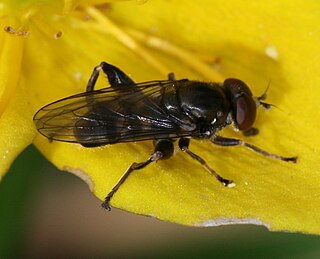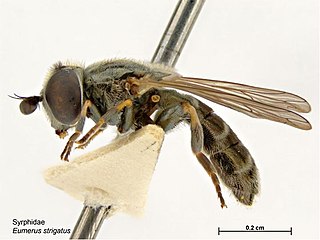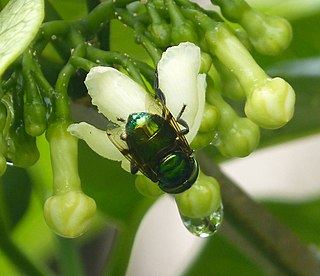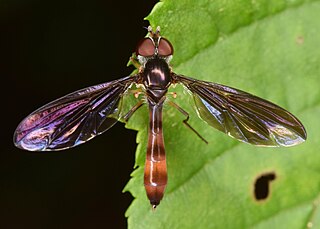
Hoverflies, also called flower flies or syrphids, make up the insect family Syrphidae. As their common name suggests, they are often seen hovering or nectaring at flowers; the adults of many species feed mainly on nectar and pollen, while the larvae (maggots) eat a wide range of foods. In some species, the larvae are saprotrophs, eating decaying plant and animal matter in the soil or in ponds and streams. In other species, the larvae are insectivores and prey on aphids, thrips, and other plant-sucking insects.

Platycheirus is a large genus of hoverflies. They are also called sedgesitters.

Sphaerophoria is a genus of hoverflies. Species slender 5.6-12mm long with extremely large hemispherical male terminalia after which the common name globetail has been created. There are bright yellow markings on head and thorax and usually on the abdomen but some species have a black abdomen. They can be found worldwide but are common in North America, Europe, Asia and Australia. There are over 73 described species.

Chalcosyrphus (Xylotomima) nemorum , the Dusky-banded Leafwalker, is a common species of syrphid fly with a Palearctic and Nearctic distribution. Hoverflies get their names from the ability to remain nearly motionless while in flight. The adults are also known as flower flies for they are commonly found around and on flowers, from which they get both energy-giving nectar and protein-rich pollen. Larvae have been found under the bark of Larix, Pinus and a variety of hardwoods.
Nausigaster is a genus of syrphid flies, or hoverflies, in the family Syrphidae. Larvae have been recorded from decaying cacti and bromeliads.

Eumerus strigatus ,, the Onion Bulb Fly , is a fairly common species of syrphid fly observed acoss Europe. Also found in north-central North America and other scattered locations as an introduced species from infested bulbs. Syrphid flies are also known as Hover Flies or Flower Flies because the adults are frequently found hovering around flowers from which they feed on nectar and pollen. The larvae feed on various bulbs. .

Copestylum violaceum, the purple bromeliad fly, is a species of syrphid fly in the family Syrphidae.

Somula is a genus of syrphid flies in the family Syrphidae. There are at least two described species in Somula.
Copestylum fornax is a species of syrphid fly in the family Syrphidae.

Ornidia obesa is a species of syrphid fly in the family Syrphidae.

Hypocritanus fascipennis is a species of syrphid fly in the family Syrphidae. Until 2020, it was classified in the genus Ocyptamus. The common name is the eastern band winged hover fly.
Salpingogaster is a genus of syrphid flies in the family Syrphidae. There are at least 30 described species in Salpingogaster.
Spilomyia foxleei is a species of syrphid fly in the family Syrphidae.
Platycheirus normae, the paddlearm sedgesitter, is a rare species of syrphid fly observed in northeastern North America. Hoverflies can remain nearly motionless in flight. The adults are also known as flower flies for they are commonly found on flowers, from which they get both energy-giving nectar and protein-rich pollen. Larvae are aphid predators.
Sphaerophoria asymmetrica , the asymmetric globetail , is a common species of syrphid fly observed across northern North America. Hoverflies can remain nearly motionless in flight. The adults are also known as flower flies for they are commonly found on flowers from which they get both energy-giving nectar and protein rich pollen. The larvae feed on aphids.
Total of 245 species either found or highly expected to be found in New York.

Sphaerophoria bifurcata, the symmetric globetail, is a species of syrphid fly in the family Syrphidae. The larvae of this genus are predators of aphids and other small hymenoptera. The larvae of this particular species is not known.











